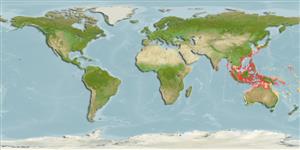Trophic ecology
Voedselitems
Diet compositions
Food consumptions
Food rations
Predatoren
Ecology
Ecologie
Home ranges
Population dynamics
Growths
Max. ages / sizes
Length-weight rel.
Length-length rel.
Lengtefrequenties
Mass conversions
Recruitments
Abundances
Physiology
Body compositions
Nutrients
Oxygen consumptions
Zwemtype
Swimming speeds
Visual pigment(s)
Visgeluiden
Diseases / Parasites
Toxicities (LC50s)
Genetics
Genetica
Electrophoreses
Heritabilities
